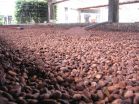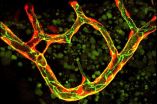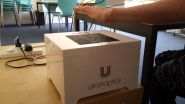INFORMATION:
The research was supported by Penn State, the University's College of Agricultural Sciences, The Huck Institutes of Life Sciences and the American Research Institute Penn State Endowed Program in the Molecular Biology of Cacao.
Discovery of gene that determines cocoa butter melting point to have far-reaching effects
2015-04-20
(Press-News.org) The discovery of a gene involved in determining the melting point of cocoa butter -- a critical attribute of the substance widely used in foods and pharmaceuticals -- will likely lead to new and improved products, according to researchers in Penn State's College of Agricultural Sciences.
The finding by plant geneticists also should lead to new varieties of the cocoa plant that could extend the climate and soil-nutrient range for growing the crop and increase the value of its yield, they said, providing a boost to farmers' incomes in the cocoa-growing regions of the world.
Cacao, Theobroma cacao L., is an understory tropical tree domesticated in the Amazon basin and today widely cultivated in West Africa, Central and South America and Southeast Asia. Around the world, more than five million cocoa farmers -- and more than 40 million people total -- depend on cocoa for their livelihood, according to the World Cocoa Foundation, which puts annual cocoa production worldwide at 3.8 million tons, valued at $11.8 billion.
Cacao pods, each containing around 40 seeds, are harvested approximately 20 weeks after pollination. The seeds contain about 50 percent total lipids (cocoa butter), which provides a main raw ingredient for chocolate manufacturing as well as ingredients for pharmaceutical and cosmetic products.
Cocoa butter with altered melting points may find new uses in specialty chocolates, cosmetics and pharmaceuticals, said lead researcher Mark Guiltinan, professor of plant molecular biology, who has been conducting research on the cacao tree for three decades. For example, a chocolate with a higher or lower melting point would be useful for production of chocolate with specific textures and specialty applications.
"The 'snap' and 'melt' of chocolate are two very important textural features that determine the appeal of chocolate to consumers, and having new varieties of the cocoa plant that produce butter with different melting points would be a valuable resource to control those characteristics," Guiltinan explained. "Medical applications could include production of drug-delivery products with slower release of drugs than is possible with current cocoa-butter-based systems."
Collaborating on the research were Siela Maximova, senior scientist and associate professor of horticulture, and Yufan Zhang, who received a doctoral degree in plant biology in January of 2015.
In a previous study, a stearoyl-acyl carrier protein desaturase (SAD) gene family was first described in the chocolate tree, by Guiltinan's laboratory and collaborators from the International Cocoa Genome Consortium, which sequenced the entire genome of the plant.
In this follow-up research, described this month online in Frontiers in Plant Science (Plant Genetics and Genomics Section), the SAD gene family is examined in detail, and the expression patterns of each SAD gene in various cacao tissues is explored along with functional analysis to study how the enzyme works.
Researchers discovered that a single gene -- TcSAD1 -- is primarily involved in the synthesis of cocoa butter and is responsible for its melting point.
"We used state-of-the-art plant science techniques to gain evidence for the role of the SAD1 gene in cocoa butter biosynthesis," Guiltinan said. "The other SAD genes appear to play other roles in the growth of the chocolate tree, such as flower and leaf development, where these fatty acids play important roles as key components of various membrane systems. This information can be used to develop biomarkers for screening and breeding of new cacao varieties with novel fatty acid compositions of cocoa butter."
Notably, cocoa butter consists of almost equal amounts of palmitic acid, stearic acid and oleic acid. Its exact composition determines its melting temperature, which is very close to human body temperature, thus providing the smoothness and feel of chocolate in the mouth, as well as the creamy texture of cosmetics on skin.
"During cacao seed development, large amounts of fatty acids are synthesized that are rich in saturated and monounsaturated lipids," Guiltinan said. "An important part of this process is the activity of an enzyme produced by the SAD1 gene that creates a special double bond critical in determining the melting point of chocolate, that is very close to the human body temperature and makes cocoa butter quite unique."
ELSE PRESS RELEASES FROM THIS DATE:
Yale-NUS, NUS and UT Austin researchers establish theoretical framework for graphene physics
2015-04-20
Singapore, 20 April 2015 - Since the discovery of graphene about a decade ago, scientists have been studying ways to engineer electronic band gaps in the material to produce semiconductors which can create new electronic devices. A team of researchers from Yale-NUS College, the Center for Advanced 2D Materials and Department of Physics at the National University of Singapore (NUS) and the University of Texas at Austin, USA (UT Austin) have established a theoretical framework to understand the elastic and electronic properties of graphene. The findings were published in ...
Pulsing light may indicate supermassive black hole merger
2015-04-20
As two galaxies enter the final stages of merging, scientists have theorized that the galaxies' supermassive black holes will form a "binary," or two black holes in such close orbit they are gravitationally bound to one another. In a new study, astronomers at the University of Maryland present direct evidence of a pulsing quasar, which may substantiate the existence of black hole binaries.
"We believe we have observed two supermassive black holes in closer proximity than ever before," said Suvi Gezari, assistant professor of astronomy at the University of Maryland and ...
Telling the time by color
2015-04-20
Research by scientists at The University of Manchester has revealed that the colour of light has a major impact on how our body clock measures the time of day.
It's the first time the impact of colour has been tested and demonstrates that colour provides a more reliable way of telling the time than measuring brightness.
In research being published on April 17th in the Open Access journal PLOS Biology, the researchers looked at the change in light around dawn and dusk to analyse whether colour could be used to determine time of day. Besides the well-known changes in ...
Pruning of blood vessels: Cells can fuse with themselves
2015-04-20
Cells of the vascular system of vertebrates can fuse with themselves. This process, which occurs when a blood vessel is no longer necessary and pruned, has now been described on the cellular level by Prof. Markus Affolter from the Biozentrum of the University of Basel. The findings of this study have been published in the journal PLOS Biology.
The vascular system is the supply network of the human organism and delivers oxygen and nutrients to the last corners of the body. So far, research on the vascular system has focused primarily on the formation of such vascular networks. ...
Darwin, Wallace, and the overlooked third man
2015-04-20
The horticulturist who came up with the concept of 'evolution by natural selection' 27 years before Charles Darwin did should be more widely acknowledged for his contribution, states a new paper by a King's College London geneticist.
The paper, published in the Biological Journal of the Linnean Society, argues that Patrick Matthew deserves to be considered alongside Charles Darwin and Alfred Russel Wallace as one of the three originators of the idea of large-scale evolution by natural selection.
Furthermore, Matthew's version of evolution by natural section captures ...
Technology can transfer human emotions to your palm through air, say scientists
2015-04-20
Human emotion can be transferred by technology that stimulates different parts of the hand without making physical contact with your body, a University of Sussex-led study has shown.
Sussex scientist Dr Marianna Obrist, Lecturer at the Department of Informatics, has pinpointed how next-generation technologies can stimulate different areas of the hand to convey feelings of, for example, happiness, sadness, excitement or fear.
For example, short, sharp bursts of air to the area around the thumb, index finger and middle part of the palm generate excitement, whereas sad ...
Is there such a thing as 'pure' autism?
2015-04-20
Philadelphia, PA, April 20, 2015 - The search for genes that contribute to the risk for autism has made tremendous strides over the past 3 years. As this field has advanced, investigators have wondered whether the diversity of clinical features across patients with autism reflects heterogeneous sources of genetic risk.
If so, it was reasoned, then selecting a group of patients with very similar clinical features might result in a "purer", i.e., more genetically homogenous, group of patients, making it easier to find autism-related genes.
Results from a new study published ...
LGBT-competent physicians are scarce at US academic medical practices, UCLA study finds
2015-04-20
Research has shown that, for a number of reasons, lesbian, gay, bisexual and transgender people are significantly more likely than heterosexuals to avoid or delay medical care.
For instance, LGBT individuals who are between the ages of 18 and 44 and single are less likely than heterosexuals to have the money or insurance for care, and even partnered gays and lesbians are twice as likely to be uninsured. The fear of stigma and homophobia can also keep LGBT people from seeking care. And many are afraid to disclose their sexual or gender identity to their physicians, which ...
A common nerve protein elevated in aggressive neuroblastomas
2015-04-20
PHILADELPHIA - A protein produced by nerve cells appears to be elevated in the blood of those with an aggressive form of neuroblastoma. The finding, presented today at the American Association for Cancer Research 2015 Annual Meeting in Philadelphia, could potentially lead to a prognostic test for the disease or be used to monitor its progress.
Neuroblastoma is a pediatric cancer with varying types, ranging from spontaneously regressing to untreatable fatal tumors. Consequently, treatment strategies vary significantly between patients, encompassing different approaches ...
Overnight fasting may reduce breast cancer risk in women
2015-04-20
A decrease in the amount of time spent eating and an increase in overnight fasting reduces glucose levels and may reduce the risk of breast cancer among women, report University of California, San Diego School of Medicine researchers in the journal Cancer Epidemiology, Biomarkers & Prevention.
The findings were presented at the American Association of Cancer Research's annual meeting in Philadelphia.
"Increasing the duration of overnight fasting could be a novel strategy to reduce the risk of developing breast cancer," said Catherine Marinac, UC San Diego doctoral candidate ...





